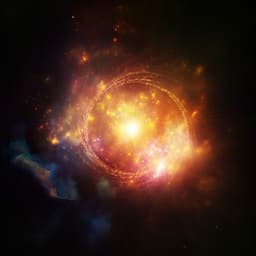
Space Sciences
A trail of dark-matter-free galaxies from a bullet-dwarf collision
P. V. Dokkum, Z. Shen, et al.
This groundbreaking research conducted by Pieter van Dokkum and colleagues explores ultra-diffuse galaxies DF2 and DF4, revealing their surprising size, luminous globular clusters, and low velocity dispersions. The study suggests these galaxies might be dark matter-free, having formed from a high-velocity collision of gas-rich galaxies approximately eight billion years ago.
~3 min • Beginner • English
Introduction
The study addresses why the ultra-diffuse galaxies NGC 1052-DF2 and NGC 1052-DF4 share the same rare combination of properties—large sizes, unusually bright and large globular clusters, and extremely low velocity dispersions implying little or no dark matter—while being close in the sky yet substantially separated along the line of sight. The hypothesis is that DF2 and DF4 formed together in a high-velocity, near head-on collision between gas-rich dwarf galaxies in the NGC 1052 group several gigayears ago (a “bullet-dwarf” event). In such collisions the collisional gas can be shocked and separated from collisionless dark matter and pre-existing stars, triggering star formation that produces dark-matter-free galaxies and massive star clusters. Intense feedback during cluster formation could then expand initially compact stellar systems to the observed large sizes, especially in the absence of a binding dark halo. The purpose is to test whether the current kinematics and 3D positions of DF2 and DF4, and the distribution of nearby faint galaxies, support a common collisional origin.
Literature Review
Prior work established the unusual properties of DF2 and DF4, including large sizes and overluminous globular clusters, and reported very low internal velocity dispersions suggesting minimal dark matter (e.g., van Dokkum et al. 2018; Danieli et al. 2019; Emsellem et al. 2019). Theoretical studies proposed that high-velocity dwarf–dwarf collisions can separate gas from dark matter and form dark-matter-deficient galaxies and their globular clusters (Silk 2019; Shin et al. 2020; Lee et al. 2021), analogous to the larger-scale bullet cluster phenomenon (Clowe et al. 2006). Distance measurements using the tip of the red giant branch (TRGB) placed DF2 and DF4 at 22.1 ± 1.2 Mpc and 20.0 ± 1.6 Mpc, respectively, indicating a 2.1 ± 0.5 Mpc line-of-sight separation. Additional studies examined the NGC 1052 group environment, halo mass, and globular cluster system properties relevant to formation scenarios. Prior simulations suggested mini–bullet-cluster-like events are plausible and potentially not rare in cosmological volumes.
Methodology
- Geometric and kinematic modeling: Use measured heliocentric radial velocities and TRGB distances for DF2 (cz = 1,803 km s⁻¹, D = 22.1 ± 1.2 Mpc) and DF4 (cz = 1,445 km s⁻¹, D = 20.0 ± 1.6 Mpc). Compute relative radial velocity V_DF2–DF4 = 358 km s⁻¹ and line-of-sight separation D_LOS = 2.1 ± 0.5 Mpc. Compare velocities relative to NGC 1052 (cz ≈ 1,488 km s⁻¹): Δv(DF2) = +315 km s⁻¹, Δv(DF4) = −43 km s⁻¹. Trace line-of-sight positions backward assuming approximately constant motion to estimate a minimum time since encounter (≥6 Gyr) and adopt an average post-collision speed v ≈ 350 km s⁻¹ for DF2 to infer a collision epoch ≈8 Gyr ago, consistent with stellar population ages in DF2 (9 ± 2 Gyr).
- Collision scenario construction: Propose a near head-on, high-speed (>300 km s⁻¹) encounter near NGC 1052 between an unbound, infalling gas-rich progenitor and a bound satellite of NGC 1052. Associate DF2 with the trajectory of the unbound progenitor and DF4 with the bound one; posit that DF2 is now unbound and ≈3 Mpc behind the group, while DF4 remained bound and is falling back.
- Search for linear substructure (trail): Compile a catalogue of low-surface-brightness galaxies in the NGC 1052 field with apparent magnitude g > 16.5. Apply a discrete Hough transform to the sky distribution to identify linear features. Identify a peak corresponding to a line with relation ΔDec = 0.45 ΔRA − 2.8 (arcminutes north and west of NGC 1052), containing 11 galaxies within ±30 kpc of the line. Assess significance via randomized realizations, yielding a ≈97% significance (≈3% chance occurrence) and ≈0.6% chance that the peak occurs by chance and includes both DF2 and DF4.
- Size–magnitude analysis: Using Legacy imaging measurements, determine the running median relation between apparent size and magnitude and fit a least-squares model: log r_e = −0.09 (g − 20) + 0.87 (kpc). Subtract the fit to compute relative sizes and compare trail members to non-members. Use a Wilcoxon test to evaluate whether size distributions differ.
- Object classification along the trail: Examine images of the 11 trail galaxies; consider chance projection contamination using average galaxy density within R < 30′ of NGC 1052, inferring 2 ± 2 interlopers (thus 7–11 genuine trail members). Evaluate morphology and proximity (e.g., DF5 near DF4) and identify candidates for dark-matter-dominated progenitor remnants (RCP 32 and DF7) ahead of DF2 and DF4.
- Predictive relations for follow-up: From the geometric model, provide approximate gradients for radial velocity and distance along the trail as functions of ΔRA (relative to NGC 1052): cz ≈ 1,700 − 10 ΔRA km s⁻¹ and D ≈ 21.5 − 0.06 ΔRA Mpc (with expected scatter), normalized to DF2’s TRGB distance.
- Consistency checks: Compare tidal morphologies and identical tidal distortions of DF2 and DF4 with the hypothesized equal initial tidal fields at formation; cross-check age of DF2’s globular clusters and diffuse light with collision timing.
Key Findings
- DF2 and DF4 likely formed together in a high-velocity, near head-on collision (“bullet-dwarf” event) in the NGC 1052 group about 8 Gyr ago. Evidence includes:
• Large relative radial velocity V_DF2–DF4 = 358 km s⁻¹, about three times the group velocity dispersion (~115 km s⁻¹).
• Large line-of-sight separation of 2.1 ± 0.5 Mpc despite only 0.24 Mpc projected separation.
• Velocities relative to NGC 1052 consistent with DF4 moving toward and DF2 moving away: Δv(DF4) = −43 km s⁻¹; Δv(DF2) = +315 km s⁻¹.
• Back-tracing implies a high-speed encounter ≥6 Gyr ago; adopting average post-collision speed v ≈ 350 km s⁻¹ for DF2 yields a collision epoch ≈8 Gyr ago, matching DF2 stellar/GC ages (9 ± 2 Gyr).
- Linear substructure (trail): A Hough transform of faint galaxy positions reveals 11 galaxies aligned along ΔDec = 0.45 ΔRA − 2.8, with ≈97% significance; chance probability ≈3% and ≈0.6% that both DF2 and DF4 would be included by chance. Accounting for 2 ± 2 interlopers implies 7–11 true members. The trail length is ≳2 Mpc and inclined 7° ± 2° from the line of sight.
- Structural properties: Trail galaxies are on average 26% larger than other faint group members at the same magnitude; a Wilcoxon test gives p < 1% that the size distributions are the same.
- Candidate remnants: RCP 32 and DF7, located ahead of DF2 and DF4 respectively, are tentatively identified as the dark-matter-dominated remnants of the two progenitor galaxies. DF5, very close in projection to DF4 and of extremely low surface brightness, is proposed as another dark-matter-free fragment from the collision.
- Predictive gradients: Along the trail, galaxies are predicted to follow cz ≈ 1,700 − 10 ΔRA km s⁻¹ and D ≈ 21.5 − 0.06 ΔRA Mpc (with scatter).
Discussion
The observed kinematics and three-dimensional configuration of DF2 and DF4, together with the discovery of an aligned trail of unusually large, low-surface-brightness galaxies, support a common origin in a high-velocity dwarf–dwarf collision near NGC 1052. This scenario naturally explains the lack of dark matter in DF2 and DF4 via separation of gas from collisionless dark matter, followed by star formation in compressed gas that produced massive globular clusters. Feedback-driven expansion can account for the large sizes of the resulting galaxies, particularly in the absence of confining dark halos. The similar tidal morphologies of DF2 and DF4 are consistent with equal tidal fields at formation and no subsequent stronger perturbations. The identification of leading objects (RCP 32 and DF7) as potential dark-matter-dominated remnants aligns with expectations that collision remnants with the highest velocities relative to the barycentre should precede dark-matter-deficient fragments. The trail’s elevated fraction of large galaxies further connects the event to the unusual population of diffuse systems in the group. The work also provides testable predictions (globular cluster ages in DF4 matching DF2’s 9 ± 2 Gyr; baryon-only kinematics for most trail galaxies; velocity and distance gradients along the trail) and has implications for constraining dark matter self-interaction cross-sections on small scales through modeling of such bullet-dwarf events.
Conclusion
The paper presents evidence that DF2 and DF4 formed in the same high-velocity collision in the NGC 1052 group about 8 Gyr ago and identifies a >2 Mpc linear trail of 7–11 large, faint galaxies likely created by this event. The proposed geometry explains the galaxies’ current velocities, distances, morphologies, and the presence of unusually bright, large globular clusters in dark-matter-deficient hosts. Candidate dark-matter-dominated remnants (RCP 32 and DF7) are identified at the leading edge of the trail. The study offers specific, falsifiable predictions: DF4’s globular clusters should share the 9 ± 2 Gyr ages of DF2’s clusters; most trail members should show kinematics consistent with little or no dark matter, while RCP 32 and DF7 could have unusually low baryon fractions; and radial velocities and distances should vary approximately linearly with position along the trail. Future work should obtain precise TRGB distances and spectroscopy for trail galaxies and globular clusters, measure internal kinematics to test baryon-only mass models, and model additional bullet-dwarf systems to constrain dark matter self-interactions on dwarf-galaxy scales.
Limitations
- The reconstructed collision geometry is not unique; alternative configurations may reproduce current positions and velocities.
- Time since collision estimates (≥6–8 Gyr) assume approximately constant motion along the line of sight and simplified dynamical histories.
- The linear feature’s significance, while high (≈97%), allows for 2 ± 2 chance projections among the 11 candidates; 0–4 interlopers are expected and object classifications (e.g., LEDA 4014647, RCP 26, Ta21-12000) may include unrelated group members.
- Predicted velocity and distance gradients along the trail likely have considerable scatter and may deviate from linearity depending on the true 3D geometry.
- Identification of RCP 32 and DF7 as progenitor remnants is tentative and based on positional and morphological arguments without definitive dynamical mass measurements.
- Ages of DF4’s globular clusters have not yet been measured; direct spectral comparisons are needed to test the common-formation hypothesis.
Related Publications
Explore these studies to deepen your understanding of the subject.







